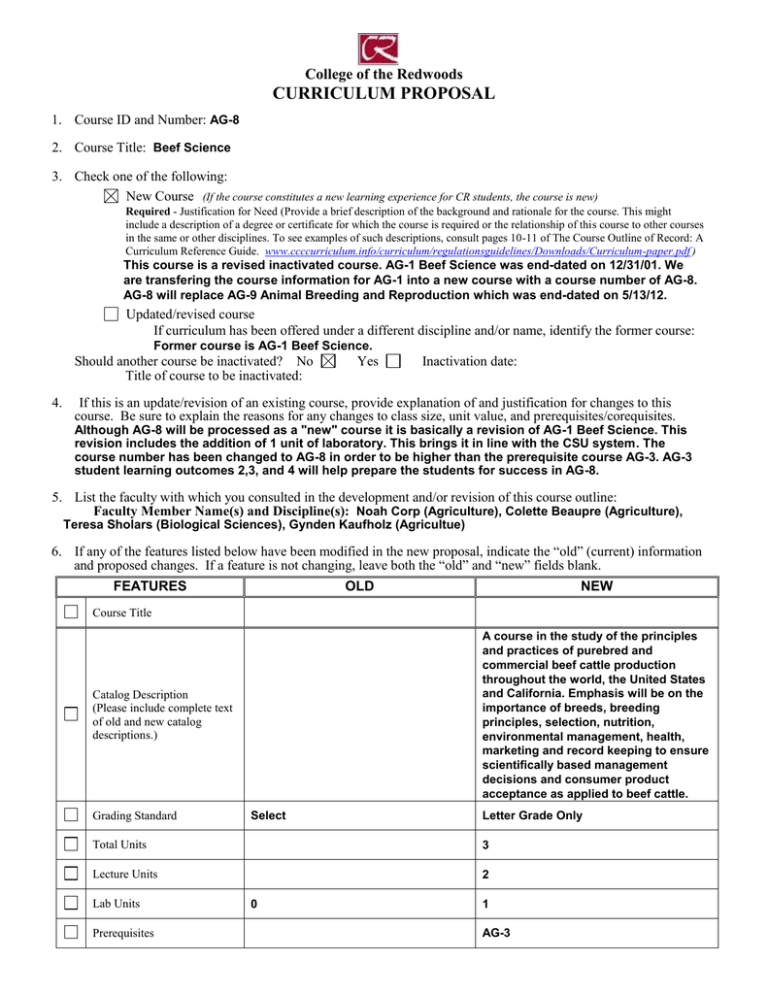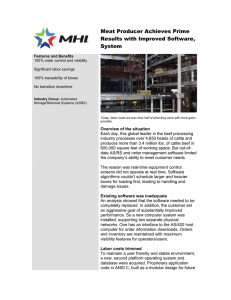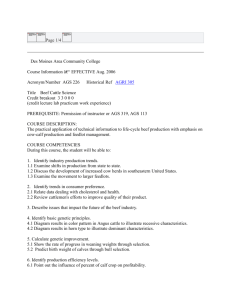CURRICULUM PROPOSAL College of the Redwoods 1. Course ID and Number:
advertisement

College of the Redwoods CURRICULUM PROPOSAL 1. Course ID and Number: AG-8 2. Course Title: Beef Science 3. Check one of the following: New Course (If the course constitutes a new learning experience for CR students, the course is new) Required - Justification for Need (Provide a brief description of the background and rationale for the course. This might include a description of a degree or certificate for which the course is required or the relationship of this course to other courses in the same or other disciplines. To see examples of such descriptions, consult pages 10-11 of The Course Outline of Record: A Curriculum Reference Guide. www.ccccurriculum.info/curriculum/regulationsguidelines/Downloads/Curriculum-paper.pdf ) This course is a revised inactivated course. AG-1 Beef Science was end-dated on 12/31/01. We are transfering the course information for AG-1 into a new course with a course number of AG-8. AG-8 will replace AG-9 Animal Breeding and Reproduction which was end-dated on 5/13/12. Updated/revised course If curriculum has been offered under a different discipline and/or name, identify the former course: Former course is AG-1 Beef Science. Should another course be inactivated? No Title of course to be inactivated: 4. Yes Inactivation date: If this is an update/revision of an existing course, provide explanation of and justification for changes to this course. Be sure to explain the reasons for any changes to class size, unit value, and prerequisites/corequisites. Although AG-8 will be processed as a "new" course it is basically a revision of AG-1 Beef Science. This revision includes the addition of 1 unit of laboratory. This brings it in line with the CSU system. The course number has been changed to AG-8 in order to be higher than the prerequisite course AG-3. AG-3 student learning outcomes 2,3, and 4 will help prepare the students for success in AG-8. 5. List the faculty with which you consulted in the development and/or revision of this course outline: Faculty Member Name(s) and Discipline(s): Noah Corp (Agriculture), Colette Beaupre (Agriculture), Teresa Sholars (Biological Sciences), Gynden Kaufholz (Agricultue) 6. If any of the features listed below have been modified in the new proposal, indicate the “old” (current) information and proposed changes. If a feature is not changing, leave both the “old” and “new” fields blank. FEATURES OLD NEW Course Title A course in the study of the principles and practices of purebred and commercial beef cattle production throughout the world, the United States and California. Emphasis will be on the importance of breeds, breeding principles, selection, nutrition, environmental management, health, marketing and record keeping to ensure scientifically based management decisions and consumer product acceptance as applied to beef cattle. Catalog Description (Please include complete text of old and new catalog descriptions.) Grading Standard Select Letter Grade Only Total Units 3 Lecture Units 2 Lab Units Prerequisites 0 1 AG-3 Corequisites Recommended Preparation ENGL-150 Maximum Class Size 24 Repeatability— Maximum Enrollments 0 Other College of the Redwoods COURSE OUTLINE 1. DATE: 9/29/11 2. DIVISION: Business and Applied Technology 3. COURSE ID AND NUMBER: AG-8 4. COURSE TITLE (appears in catalog and schedule of classes): Beef Science 5. SHORT TITLE (appears on student transcripts; limited to 30 characters, including spaces): Beef Science 6. LOCAL ID (TOPS): 0102.00 (Taxonomy of Program codes http://www.cccco.edu/Portals/4/TopTax6_rev0909.pdf) 7. NATIONAL ID (CIP): 01.0302 (Classification of Instructional Program codes can be found in Appendix B of the TOPS code book http://www.cccco.edu/Portals/4/AA/CrosswalkTOP6to2010CIP.pdf) 8. Discipline(s): Select from CCC System Office Minimum Qualifications for Faculty http://www.cccco.edu/Portals/4/AA/Minimum%20Qualifications%20Handbook%20for%202010-2012.pdf Course may fit more than one discipline; identify all that apply: Agriculture 9. FIRST TERM NEW OR REVISED COURSE MAY BE OFFERED: Spring 2013 10. TOTAL UNITS: 3 TOTAL HOURS: 90 [Lecture Units: 2 Lab Units: 1] [Lecture Hours: 36 Lab Hours: 54] (1 unit lecture=18 hours; 1 unit lab=54 hours) 11. MAXIMUM CLASS SIZE: 24 12. WILL THIS COURSE HAVE AN INSTRUCTIONAL MATERIALS FEE? No Yes Fee: $ (If “yes,” attach a completed “Instructional Materials Fee Request Form”—form available in Public Folders>Curriculum>Forms) GRADING STANDARD Letter Grade Only Pass/No Pass Only Is this course a repeatable lab course: No Yes Grade-Pass/No Pass Option If yes, how many total enrollments? Is this course to be offered as part of the Honors Program? No Yes If yes, explain how honors sections of the course are different from standard sections. CATALOG DESCRIPTION -- The catalog description should clearly describe for students the scope of the course, its level, and what kinds of student goals the course is designed to fulfill. The catalog description should begin with a sentence fragment. A course in the study of the principles and practices of purebred and commercial beef cattle production throughout the world, the United States and California. Emphasis will be on the importance of breeds, breeding principles, selection, nutrition, environmental management, health, marketing and record keeping to ensure scientifically based management decisions and consumer product acceptance as applied to beef cattle. Special notes or advisories (e.g. field trips required, prior admission to special program required, etc.): Field trips may be required. PREREQUISITE COURSE(S) No Yes Course(s): AG 3 Introduction to Animal Science Rationale for Prerequisite: Describe representative skills without which the student would be highly unlikely to succeed. The prerequisite gives the student a basic understanding of the principles of beef nutrition and reproduction. COREQUISITE COURSE(S) No Yes Course(s): Rationale for Corequisite: RECOMMENDED PREPARATION No Yes Course(s): English 150. Rationale for Recommended Preparation: Students will be required to write at the college level. COURSE LEARNING OUTCOMES –This section answers the question “what will students be able to do as a result of taking this course?” State some of the objectives in terms of specific, measurable student actions (e.g. discuss, identify, describe, analyze, construct, compare, compose, display, report, select, etc.). For a more complete list of outcome verbs please see Public Folders>Curriculum>Help Folder>SLO Language Chart. Each outcome should be numbered. 1. 2. 3. 4. Discuss the history and development of the beef industry. Compare beef breeds and their adaptability to climatic conditions and type of operations. Identify common diseases and parasites and the current methods of prevention and treatment. Discuss animal welfare issues, environmental concerns and the beef cattle quality assurance program. COURSE CONTENT–This section describes what the course is “about”-i.e. what it covers and what knowledge students will acquire Concepts: What terms and ideas will students need to understand and be conversant with as they demonstrate course outcomes? Each concept should be numbered. 1. Care and management of the breeding herd. 2. Beef animal preparation for seed stock sales . 3. Buildings and equipment. 4. Principles of beef cattle genetics. 5. Percentage of heritability of beef traits. 6. Economically important beef traits. 7. Digestion and utilization of feed. 8. Nutrient requirements for beef cattle. 9. Rations for beef cattle. 10. Range management. 11. Common diseases of cattle. 12. Control of parasites. 13. Poisonous plants that affect cattle. 14. Marketing purebred and commercial cattle. 15. USDA yield and quality grades. Issues: What primary tensions or problems inherent in the subject matter of the course will students engage? Each issue should be numbered. 1. Animal/welfare issues. 2. Quality assurance program. 3. Environmental issues. 4. Beef cattle production cycles. 5. Regulations in the beef cattle industry. Themes: What motifs, if any, are threaded throughout the course? Each theme should be numbered. 1. Beef cattle management practices. 2. Beef cattle genetics. 3. Beef cattle nutrition. 4. Herd health. 5. Marketing beef cattle. Skills: What abilities must students have in order to demonstrate course outcomes? (E.g. write clearly, use a scientific calculator, read college-level texts, create a field notebook, safely use power tools, etc). Each skill should be numbered. 1. 2. 3. 4. 5. 6. Describe the common systems of beef production. Explain the principles of genetics in terms of form and function in the beef industry. Define the relationship between the consumer, packer, and retailer in the commercial beef industry. Explain grading systems and marketing strategies. Explain the principles involved with ruminant nutrition in beef production. Demonstrate the use of computer management systems to efficiently manage beef cattle operations. 7. Discuss career opportunities and requirements for successful employment. 8. Identify cultural influences on the beef industry. 9. Comprehend complex arguments. 10. Distinguish between cause and effect. 11. Analyze problems and create possible solutions. 12. Formulate verbal and written answers to questions. 13. Keep detailed records and summarize gathered data. REPRESENTATIVE LEARNING ACTIVITIES –This section provides examples of things students may do to engage the course content (e.g., listening to lectures, participating in discussions and/or group activities, attending a field trip). These activities should relate directly to the Course Learning Outcomes. Each activity should be numbered. 1. 2. 3. 4. Attending lectures and labs. Problem-solving, individually and in groups. Reading of related materials. Conducting research and analysis. ASSESSMENT TASKS –This section describes assessments instructors may use to allow students opportunities to provide evidence of achieving the Course Learning Outcomes. Each assessment should be numbered. Representative assessment tasks (These are examples of assessments instructors could use): 1. Written and skill-based quizzes and exams. 2. Out-of-class term paper drawing on material presented in class, in reading materials as well as additional resources. 3. Class participation. Required assessments for all sections (These are assessments that are required of all instructors of all sections at all campuses/sites. Not all courses will have required assessments. Do not list here assessments that are listed as representative assessments above.): 1. EXAMPLES OF APPROPRIATE TEXTS OR OTHER READINGS –This section lists example texts, not required texts. Author, Title, and Date Fields are required Author Field Title Beef Production Management and Decisions 5th Ed Author Ensminger and Perry Title Beef Cattle Science 7th Ed. Date Date 2007 1997 Author University of Idaho College of Agriculture Cooperative Extension System Management Guide and Cattle Producer's Library Date 2011 Author Title Title Cow-Calf Date Other Appropriate Readings: COURSE TYPES 1. Is the course part of a Chancellor’s Office approved CR Associate Degree? No Yes If yes, specify all program codes that apply. (Codes can be found in Outlook/Public Folders/All Public Folders/ Curriculum/Degree and Certificate Programs/choose appropriate catalog year): Required course for degree(s) Restricted elective for degree (s) Restricted electives are courses specifically listed (i.e. by name and number) as optional courses from which students may choose to complete a specific number of units required for an approved degree. 2. Is the course part of a Chancellor’s Office approved CR Certificate of Achievement? No Yes If yes, specify all program codes that apply. ( Codes can be found in Outlook/Public Folders/All Public Folders/ Curriculum/Degree and Certificate Programs/choose appropriate catalog year): Required course for certificate(s) Restricted elective for certificate(s) Restricted electives are courses specifically listed (i.e. by name and number) as optional courses from which students may choose to complete a specific number of units required for an approved certificate. 3. Is the course Stand Alone? No Yes (If “No” is checked for BOTH #1 & #2 above, the course is stand alone) 4. Basic Skills: NBS Not Basic Skills 5. Work Experience: NWE Not Coop Work Experience 6. Course eligible Career Technical Education funding (applies to vocational and tech-prep courses only): yes 7. Purpose: Y Credit Course 8. Accounting Method: W Weekly Census 9. Disability Status: N Not a Special Class no CURRENT TRANSFERABILITY STATUS (Check at least one box below): This course is currently transferable to Neither CSU nor UC CSU as general elective credit CSU as a specific course equivalent (see below) If the course transfers as a specific course equivalent, give course number(s)/ title(s) of one or more currently-active, equivalent lower division courses from CSU. 1. Course , Campus 2. Course , Campus UC as general elective credit UC as specific course equivalent If the course transfers as a specific course equivalent, give course number(s)/ title(s) of one or more currently-active, equivalent lower division courses from UC. 1. Course , Campus 2. Course , Campus PROPOSED CSU TRANSFERABILITY (Check at least one of the boxes below): No proposal Remove as General Education Propose as General Elective Credit Propose as a Specific Course Equivalent (see below) If specific course equivalent credit is proposed, give course number(s)/ title(s) of one or more currently-active, equivalent lower division courses from CSU. 1. Course ANSC 171, Campus CSU Chico 2. Course ASCI 221, Campus CPSLO PROPOSED UC TRANSFERABILITY (Check one of the boxes below): No proposal Remove as General Education Propose as General Elective Credit OR Specific Course Equivalent (fill in information below) If “General Elective Credit OR Specific Course Equivalent” box above is checked, give course number(s)/ title(s) of one or more currently-active, equivalent lower division courses from UC. 1. Course , Campus 2. Course , Campus CURRENTLY APPROVED GENERAL EDUCATION Check at least one box below): Not currently approved CR CR GE Category: CSU CSU GE Category: IGETC IGETC Category: PROPOSED CR GENERAL EDUCATION (Check at least one box below): No proposal Remove as General Education Review to maintain CR GE Status New GE Proposal CR GE Outcomes GE learning outcomes in Effective Communication, Critical Thinking, Global Awareness must be addressed in all general education courses. Effective Communications: Explain how the proposed GE course fulfills at least one of the CR GE outcomes in this category. Critical Thinking: Explain how the proposed GE course fulfills at least one of the CR GE outcomes in this category. Global Awareness: Explain how the proposed GE course fulfills at least one of the CR GE outcomes in this category. GE Criteria for Breadth and Generality GE courses should be broad and general in scope. Typically such courses are introductory-- not advanced or specialized—and the content encompasses a broad spectrum of knowledge within a given field of study. Explain how the proposed GE course fulfills GE criteria for breadth and generality. CR GE Area Designation Course Learning Outcomes and Course Content should provide evidence of appropriate GE Area Designation. Additional rationale for GE Area Designation (optional): Natural Science Social Science Humanities Language and Rationality Writing Oral Communications Analytical Thinking PROPOSED CSU GENERAL EDUCATION BREADTH (CSU GE) (Check at least one box below): No proposal A. Communications and Critical Thinking A1 – Oral Communication A2 – Written Communication A3 – Critical Thinking C. Arts, Literature, Philosophy, and Foreign Language C1 – Arts (Art, Dance, Music, Theater) C2 – Humanities (Literature, Philosophy, Foreign Language) E. Lifelong Understanding and Self-Development E1 – Lifelong Understanding E2 – Self-Development B. Science and Math B1 – Physical Science B2 – Life Science B3 – Laboratory Activity B4 – Mathematics/Quantitative Reasoning D. Social, Political, and Economic Institutions D0 – Sociology and Criminology D1 – Anthropology and Archeology D2 – Economics D3 – Ethnic Studies D5 – Geography D6 – History D7 – Interdisciplinary Social or Behavioral Science D8 – Political Science, Government and Legal Institutions D9 – Psychology Rationale for inclusion in this General Education category: Same as above Curriculum Proposal: 04/08/11 (rev.) Academic Senate Approved: 4/15/11 Page 7 of 8 Proposed Intersegmental General Education Transfer Curriculum (IGETC) (Check at least one box below ): No proposal 1A – English Composition 1B – Critical Thinking-English Composition 1C – Oral Communication (CSU requirement only) 2A – Math 3A – Arts 3B – Humanities 4A – Anthropology and Archaeology 4B – Economics 4E – Geography 4F – History 4G – Interdisciplinary, Social & Behavioral Sciences 4H – Political Science, Government & Legal Institutions 4I – Psychology 4J – Sociology & Criminology 5A – Physical Science 5B – Biological Science 6A – Languages Other Than English Rationale for inclusion in this General Education category: Same as above Submitted by: Franz Rulofson Division Chair/Director: Jeff Cummings Approved by Curriculum Committee: No Academic Senate Approval Date: 4/6/12 Curriculum Proposal: 04/08/11 (rev.) Academic Senate Approved: 4/15/11 Tel. Ext. 4273 Review Date: 3/15/12 Date: 2/27/12 CURRICULUM COMMITTEE USE ONLY Yes Date: 3/23/12 Board of Trustees Approval Date: 5/1/12 Page 8 of 8




